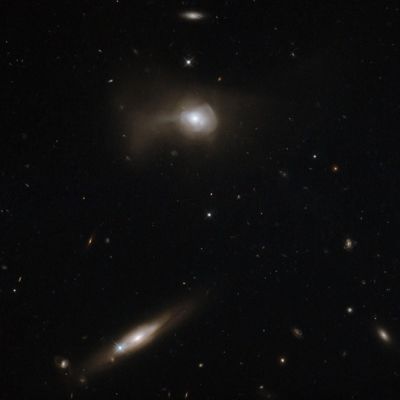
Fig. 1
A Hubble Space Telescope image of a bizarre galaxy, known as Marakrian 779, visible in the top of image.
Credit: ESA/Hubble & NASA
Many galaxies are like our Milky Way Galaxy, showing beautiful spiral arms wrapping around a bright nucleus. Examples in this wonderful image, acquired by the NASA’s Hubble Space Telescope (HST), include the tilted galaxy at the bottom left of the image, glowing beyond a Milky Way star, and the small spiral galaxy at the top center.
Other galaxies are even more bizarre in shape. Markarian 779, the galaxy at the top of this image, has a distorted appearance, probably due to a collision with another spiral galaxy. This collision destroyed the spiral arms of the merging galaxies, and dispersed much of their gas and dust, ultimately transforming them into a single odd-shaped galaxy.
This galaxy is an entry of the Markarian catalogue, a database of over 1,500 galaxies, compiled by American astronomer B. E. Markarian, in the 1960s. Markarian surveyed the sky for bright objects with unusually strong ultraviolet emission.
Ultraviolet radiation can come from various cosmic objects, so the Markarian catalog is quite diverse. Powerful ultraviolet emission can come from the nucleus of a luminous "active" galaxy, whose radiation is believed to be powered by a supermassive black hole at its center. A supermassive black hole is an extremely massive black hole, with a mass of up to several billion times the mass of the Sun.
Galaxies within which stars are being born at a high rate, known as starburst galaxies, also shine brightly in ultraviolet. Starbursts are thought to arise from collisions or close encounters of galaxies. Therefore, Markarian galaxies are often the subject of studies aimed at understanding active galaxies, starbursts, and galaxy interactions and mergers.
References
NASA
www.nasa.gov/
Wikipedia